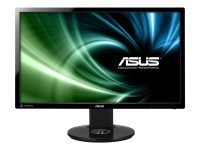Gaming on the cheap is tough, but not impossible. When it comes to monitors, it’s fairly easy to get some great screens for a low price. Of course, with a cheap gaming monitor you may have to do without some of the bells and whistles. You’ll definitely want features like full HD resolution, a good refresh rate (120Hz at least), and, of course, as big a screen as you can afford. We’ll also talk about some other technical specifics like response time and pixel pitch.

Acer may make one of the best cheap gaming monitors available in the GN246HL. Not only does it boast a 24″ screen, but it has a refresh rate of 144Hz, a response time of 1 millisecond, and a pixel pitch of 0.276 millimeters. Sure, it’s low-cost, but what’s that all mean?
Refresh Rate
The refresh rate of a monitor is how many times per second the screen can change. The higher the number, the more times it can change. Old TVs were set at 60Hz, or 60 screen refreshes per second in North America. Now, LED monitors have a far bigger range. 60Hz is still available but more common are 120Hz and 240Hz. Anywhere in this range will ensure that the visual image doesn’t lag behind the gameplay. Looking back at that Acer GN246HL, it’s refresh rate is 144Hz which means the screen refreshes every 6.94 milliseconds. While it may be difficult to find a cheap gaming monitor with a 144hz refresh rate, it’s not out of the question.
Expert Tip:
Your refresh rate on your monitor needs to be at least as fast as your graphics card can push frames per second (fps) to ensure the screen doesn’t tear, or lose of vertical synchronization. Ideally, you want a monitor that can match the fps of your graphics card, which generally costs a little more.
Response Time
Another major factor in gaming monitors is response time. This is how fast each pixel can change from black to white, or from one shade of gray to another. Most gaming monitors have a 1 millisecond response time which is great for fast action. While a frame may last up to 7 milliseconds on the screen, the pixels need to be able to change very rapidly from one frame to the next. This is why pixels have lower millisecond response times. If they don’t change fast enough there will be visual artifacts called ghosting. Cheap gaming monitors are more prone to ghosting.
Ghosting happens when some pixels don’t change fast enough and your eye is able to see the change as it happens. Essentially you’re seeing parts of two frames at the same time which not only distracts the eye but is also not optimal for fast action like gaming or movies.
Expert Tip:
Get a monitor with a 1ms response time and you should never be able to notice the individual frame changes as long as your gaming rig is pushing at least 60fps.
Pixel Pitch
Pixel pitch, in a nutshell, is how small each individual pixel is. This is the distance from the center of each pixel or cluster, to the center of the next one. Essentially, the smaller the pixel pitch, the closer one can sit to the screen without noticing individual pixels. Monitors generally have a different vertical pixel pitch and horizontal pitch and so the diagonal pixel pitch is used. A monitor with a pixel pitch of 0.248mm is roughly 100 pixels per inch. A cheap gaming monitor is most likely to have a larger pixel pitch than a more expensive one.
Expert Tip:
Most people won’t notice a difference but if you are going to stare at your monitor for hours while gaming you might as well do yourself the favor of keeping it sharp. That means 0.26-0.28mm in the 24″ monitor range, and up to 0.32mm in the 27″ range.
Cheap Gaming Monitor Recommendations
Acer GN276HL 27-inch Gaming Monitor
 Back to the actual monitors. At the top of the article I talked about the Acer GN246HL which has a refresh rate of 144Hz, a response time of 1 millisecond, and a pixel pitch of 0.276 millimeters – all well within our minimum recommended parameters. It is also Nvidia 3D Vision compatible. There is also a 27-inch version with a pixel pitch of 0.31mm.
Back to the actual monitors. At the top of the article I talked about the Acer GN246HL which has a refresh rate of 144Hz, a response time of 1 millisecond, and a pixel pitch of 0.276 millimeters – all well within our minimum recommended parameters. It is also Nvidia 3D Vision compatible. There is also a 27-inch version with a pixel pitch of 0.31mm.
ViewSonic VX2457-MHD 24-inch Gaming Monitor
 The ViewSonic VX2457-MHD (22″ and 27″ also available) offers a 2ms response time, and features AMD Freesync which allows the monitor to match its refresh rate to the fps that the graphics card is pushing out. (AMD Freesync and Nvidia G-Sync are the two major providers of this technology).
The ViewSonic VX2457-MHD (22″ and 27″ also available) offers a 2ms response time, and features AMD Freesync which allows the monitor to match its refresh rate to the fps that the graphics card is pushing out. (AMD Freesync and Nvidia G-Sync are the two major providers of this technology).
ASUS VG248QE 24-inch Gaming Monitor
 The ASUS VG248QE is another decent gaming monitor with 144Hz, 1ms response time. It also features ASUS GamePlus technology and won the 2016 PC Mag Reader’s Choice award.
The ASUS VG248QE is another decent gaming monitor with 144Hz, 1ms response time. It also features ASUS GamePlus technology and won the 2016 PC Mag Reader’s Choice award.
Regardless of what you’re looking for, there are some great cheap gaming monitor choices in the $150-250 range at 24-inches and under $300 for some 27-inch monitors as well.

